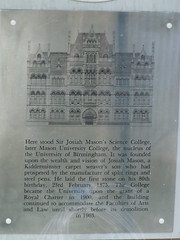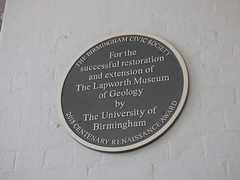University of Birmingham
University of Birmingham
(1900-present)
place and University (from 1900)
Commemorated on 2 plaques
Here stood Sir Josiah Mason's Science College, later Mason University College, the nucleus of the University of Birmingham. It was founded upon the wealth and vision of Josiah Mason, a Kidderminster carpet weaver's son who had prospered by the manufacture of split rings and steel pens. He laid the first stone on his 80th birthday, 23rd February 1875. The College became the University upon the grant of a Royal Charter in 1900, and the building continued to accommodate the Faculties of Arts and Law until shortly before its demolition in 1963.
Below Josiah Mason plaque - former Central Library, Birmingham, United Kingdom where it sited (1900-1963)
For the successful restoration and extension of The Lapworth Museum of Geology by The University of Birmingham
Lapworth Museum of Geology, University of Birmingham, Birmingham, United Kingdom where it sited (1900)


